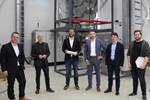Missouri S&T investigates ceramics processing through $1.4 million project
A collaborative effort with University of California, Davis and the University of Pittsburgh to achieve consistent ultra-high-temperature ceramics processing for hypersonic vehicles.
Share
Read Next
Dr. Bill Fahrenholtz (left), curators’ distinguished professor of ceramic engineering at Missouri S&T, reviews processes with undergraduate student Grace Epp (right). Fahrenholtz and his research team are trying to achieve better consistency in ultra-high-temperature ceramics for hypersonic vehicles. Photo Credit: Michael Pierce, Missouri S&T
When you order fries at McDonald’s, you expect them to taste the same in Missouri as they do in Montana. That type of consistency is what researchers at Missouri University of Science and Technology (Missouri S&T, Rolla, Mo., U.S.) are trying to achieve in ultra-high-temperature ceramics (UHTCs) processing — UHTCs melt at temperatures above 3000˚C (5500˚F) — for hypersonic vehicles. Missouri S&T is collaborating on the project with researchers at the University of California, Davis (Calif., U.S.) and the University of Pittsburgh (Pa., U.S.). The Air Force Office of Science and Research is funding the research through a $1.4 million grant.
“Ceramics are particularly sensitive to processing conditions,” Dr. Bill Fahrenholtz, curators’ distinguished professor of ceramic engineering at Missouri S&T. “One of the needs for this project is to understand how differences in composition or processing conditions cause differences in the final product so that we can get the same results every time.”
Fahrenholtz and colleagues at Missouri S&T have been researching ceramic materials for extreme environments for more than 20 years. He says his team’s role in the hypersonics project is to make ceramic materials and intentionally add impurities or change the microstructure and composition, alter production time or vary particle size in the ceramic powder. Fahrenholtz says the goal is not to eliminate flaws, but to understand how to produce a consistent product.
“The lead team at UC Davis will perform sophisticated microstructure characterization to see on a level of several microns how the changes we make in processing conditions affect the internal structure of the ceramic parts,” Fahrenholtz says. “They’ll use tools that allow a 3D analysis of the microstructure.”
Fahrenholtz adds that the team at the University of Pittsburgh will perform a statistical analysis to determine which processing factors are significant and help pinpoint the critical steps in the production process. He says the analysis will save manufacturing time and will give the Air Force a methodology that could be applied to at least all ceramic materials and perhaps a broader array of manufacturing materials.
“Collaboration is important,” Fahrenholtz says. “No one person or institution could handle this type of project. It really requires a team of people with very different skill sets.”
















.jpg;maxWidth=300;quality=90)
